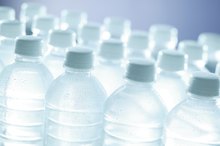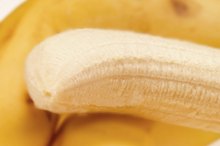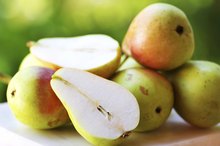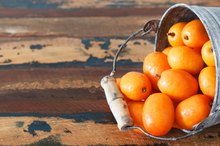What does fact checked mean?
At Healthfully, we strive to deliver objective content that is accurate and up-to-date. Our team periodically reviews articles in order to ensure content quality. The sources cited below consist of evidence from peer-reviewed journals, prominent medical organizations, academic associations, and government data.
The information contained on this site is for informational purposes only, and should not be used as a substitute for the advice of a professional health care provider. Please check with the appropriate physician regarding health questions and concerns. Although we strive to deliver accurate and up-to-date information, no guarantee to that effect is made.
Potassium and Grapes
Grapes are unique in that you can enjoy them fresh, dried, in juice form or in a variety of foods. Plants such as grapes absorb minerals through soil and water during growth, passing beneficial nutrients on to you. Grapes come in an array of flavors and colors, each one providing varying amounts of potassium, an essential dietary mineral. About 80 percent of the weight of grapes is water, making them an excellent low-calorie, nutrient-rich snack food.
Potassium Functions
Potassium is a positively charged particle residing primarily inside cellular fluid. It works hand-in-hand with sodium, which sits mostly in fluid outside of cells. These electrolyte minerals cross cell membranes, as needed, keeping fluid in check. Your body works hard to regulate this process, so electricity can allow your heart to beat, muscles to contract and nerves to communicate with one another. To support these functions, you need to consume 4,700 milligrams of potassium daily, according to the Linus Pauling Institute 1.
- Potassium is a positively charged particle residing primarily inside cellular fluid.
- It works hand-in-hand with sodium, which sits mostly in fluid outside of cells.
Grapes
Potassium Levels in Wine
Learn More
More than 50 different types of grapes can be found in stories, varying in color from white or golden, up to deep red and purple. Some grapes have seeds, while others are seedless. Your average seedless green grapes contain right around 175 milligrams of potassium per cup. Red grapes with seeds offer nearly 290 milligrams of potassium for every 1-cup serving size, while muscadine grapes, which have a deep purple color, provide 200 milligrams per cup.
- More than 50 different types of grapes can be found in stories, varying in color from white or golden, up to deep red and purple.
Juice and Jam
Grapes have a refreshing sweet flavor and are frequently made into juice or jam, another way to sneak potassium into your diet. Maximize your potassium intake by selecting grape juice that is 100 percent juice. Cocktails or blends are full of sugar and sweeteners, so you won't get all of the beneficial nutrients. An 8-ounce glass of unsweetened grape juice contains more than 250 milligrams of potassium, while the same serving of grape juice cocktail provides a minimal 80 milligrams. Spreading grape jam on your toast at breakfast or your peanut butter and jelly sandwich at lunch packs in an additional 15 milligrams of potassium.
- Grapes have a refreshing sweet flavor and are frequently made into juice or jam, another way to sneak potassium into your diet.
- Cocktails or blends are full of sugar and sweeteners, so you won't get all of the beneficial nutrients.
Raisins
Nutrition Facts of Dasani Water
Learn More
Raisins are dried grapes that contain around 15 percent water, making them a nutrient-dense snack, says the Centers for Disease Control and Prevention. A half-cup serving of raisins provides as much as 600 milligrams of potassium, about 13 percent of your total intake for the day. Fortified breakfast cereal with raisins offers approximately 360 milligrams of potassium per 1-cup serving.
- Raisins are dried grapes that contain around 15 percent water, making them a nutrient-dense snack, says the Centers for Disease Control and Prevention.
- Fortified breakfast cereal with raisins offers approximately 360 milligrams of potassium per 1-cup serving.
Related Articles
References
- Linus Pauling Institute:Potassium
- USDA National Nutrient Database for Standard Reference
- Guerrero RF, García-Parrilla MC, Puertas B, Cantos-Villar E. Wine, resveratrol and health: A review. Nat Prod Commun. 2009;4(5):635-58.
- Grapes, American type, raw. FoodData Central. U.S. Department of Agriculture. Published April 1, 2019.
- Atkinson FS, Foster-Powell K, Brand-Miller JC. International tables of glycemic index and glycemic load values: 2008. Diabetes Care. 2008;31(12):2281-3. doi:10.2337/dc08-1239
- Tomé-Carneiro J, Larrosa M, Yáñez-Gascón MJ, et al. One-year supplementation with a grape extract containing resveratrol modulates inflammatory-related microRNAs and cytokines expression in peripheral blood mononuclear cells of type 2 diabetes and hypertensive patients with coronary artery disease. Pharmacol Res. 2013;72:69-82. doi:10.1016/j.phrs.2013.03.011
- Russo M, Spagnuolo C, Tedesco I, Bilotto S, Russo GL. The flavonoid quercetin in disease prevention and therapy: Facts and fancies. Biochem Pharmacol. 2012;83(1):6-15. doi:10.1016/j.bcp.2011.08.010
- Pasinetti GM, Wang J, Ho L, Zhao W, Dubner L. Roles of resveratrol and other grape-derived polyphenols in Alzheimer's disease prevention and treatment. Biochim Biophys Acta. 2015;1852(6):1202-8. doi:10.1016/j.bbadis.2014.10.006
- Szkudelski T, Szkudelska K. Resveratrol and diabetes: from animal to human studies. Biochim Biophys Acta. 2015;1852(6):1145-54. doi:10.1016/j.bbadis.2014.10.013
- American Academy of Allergy Asthma and Immunology. Anaphylactic actions to cherries, strawberries, and grapes. Updated April 12, 2018.
- Berkeley Wellness, University of California. Types of grapes. Updated July 10, 2015.
- Grape juice, 100%. FoodData Central. U.S. Department of Agriculture. Published April 1, 2019.
- Consumer Reports. Is the cloudy coating on blueberries safe to eat?. Updated May 17, 2010.
Writer Bio
Melodie Anne Coffman specializes in overall wellness, with particular interests in women's health and personal defense. She holds a master's degree in food science and human nutrition and is a certified instructor through the NRA. Coffman is pursuing her personal trainer certification in 2015.









